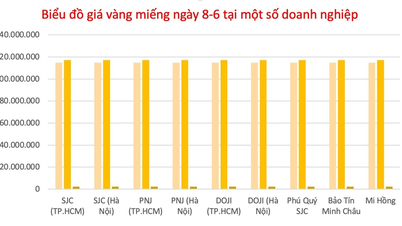SVB collapses: Will Lehman Brothers repeat its history?
Since the 2008 financial crisis, Wall Street has been preparing for the next "Lehman moment" - a reference to the 2008 collapse of investment bank Lehman Brothers, which had a devastating impact on global finance in general and on those working on Wall Street in particular.
Most recently, the collapse of Silicon Valley Bank (SVB) has reminded many people of Lehman Brothers. With more than $200 billion in assets, this is the second largest banking collapse in US history since 2008. However, according to analysts, the scale and nature of the two incidents are completely different.
SVB collapse is not a "Lehman moment"
Shares of many US banks have plunged in recent days, largely due to investors’ concerns that SVB’s losses are a sign of systemic risk spreading across the banking industry, leading to bank losses or even collapse.
However, according to many experts, this is not a "Lehman moment", at least for now.
On March 10, the Federal Deposit Insurance Corporation (FDIC) officially took over SVB. This unit will liquidate SVB’s assets to pay the bank’s depositors and creditors. Meanwhile, the bank’s parent company, SVB Financial, is struggling to find a buyer for its assets.
However, like Lehman, this will be very difficult, leading to the possibility of a complete collapse. In other words, a Lehman Brothers-like collapse is almost inevitable for SVB.

SVB officially collapsed on March 10 (Photo: Getty).
But the good news is that the impact of SVB's collapse is unlikely to be as severe as Lehman Brothers.
SVB's business is quite unique in that it primarily serves venture capital firms and startups in Silicon Valley, which increases SVB's risk if its core customers run into trouble and need to withdraw their deposits.
Meanwhile, other large banks like JPMorgan have a more diversified customer base and do not need to worry too much about selling long-term bonds to meet customer withdrawal needs.
Paul Krugman - American economist who won the Nobel Prize in Economics in 2008, also does not think that SVB's collapse is similar to Lehman Brothers.
He argued why SVB’s failure is not a “harbinger for the entire banking system” or a repeat of Lehman Brothers. According to Krugman, SVB’s deposits have surged because the unit is a key part of the tech venture ecosystem that has received a lot of capital during the pandemic.
“In my opinion, SVB is unusually good at cultivating relationships with Silicon Valley, specifically venture capital firms,” the professor commented.
Krugman believes there is little chance of contagion to other banks. "I think this is more of a small-scale crisis," he said.
Difference in scale
In terms of size, SVB is the 16th largest bank in the US with assets of 209 billion USD. Meanwhile, at the time of bankruptcy, Lehman Brothers was the fourth largest investment bank in the US with assets of 639 billion USD. Therefore, SVB is still considered not strong enough to cause a similar crisis in 2008.
Lehman Brothers filed for bankruptcy on September 15, 2008, causing the Dow Jones index to drop more than 500 points - the biggest drop since the market reopened after September 11, 2001. Meanwhile, the Nasdaq index fell 81.36 points and the S&P 500 index fell 59 points. On September 15 and 16, all European exchanges and Asian stock markets that were not closed for the Mid-Autumn Festival lost value.

The bankruptcy of Lehman Brothers shocked the world (Photo: Getty).
As for the impact of SVB, many major US bank stocks were sold off simultaneously. Specifically, the capitalization of the four largest US banks, JPMorgan, Bank of America, Wells Fargo and Morgan Stanley, was blown away by a total of $55 billion in just the trading session on March 9.
Even the stocks of some banks such as First Republic Bank, PacWest and Signature Bank were suspended. However, by March 10, JPMorgan shares had recovered slightly while First Republic Bank's stock price fell another 20%.
At the end of the trading session on March 10, the Dow Jones index fell for the fourth consecutive session, losing 345.22 points. The S&P 500 index and the Nasdaq Composite index also fell slightly.
According to Deepak Shenoy, an expert at Capitalmind consulting firm, SVB is not as large as Lehman, but more like the $126 billion hedge fund Long-Term Capital Management. In 1998, Long-Term Capital Management almost collapsed but was lucky to escape that situation.
On March 10, US Deputy Secretary of the Treasury - Wally Adeyemo reassured people about the health of the country's banking system. "Federal authorities are monitoring SVB. At this time, we remain confident in the health of the entire system. We have the necessary tools to respond to incidents similar to what happened to SVB," said Mr. Adeyemo.
Not only that, concerns about the chain reaction in the financial system after this incident are also less because since the 2008 financial crisis, the US has reformed many regulations on banking management.
Former US Treasury Secretary Larry Summers has warned of "consequences for Silicon Valley and for the venture capital economy" if the government does not intervene but said there would be no systemic risk if the SVB affair was properly resolved.
Sharing the same view, analyst Mike Mayo of Wells Fargo bank believes that the crisis at SVB is just an isolated case.
Content: Hanh Vu (compiled)
March 13, 2023
Source
























































































![[OCOP REVIEW] Tu Duyen Syrup - The essence of herbs from the mountains and forests of Nhu Thanh](https://vphoto.vietnam.vn/thumb/402x226/vietnam/resource/IMAGE/2025/6/5/58ca32fce4ec44039e444fbfae7e75ec)






Comment (0)